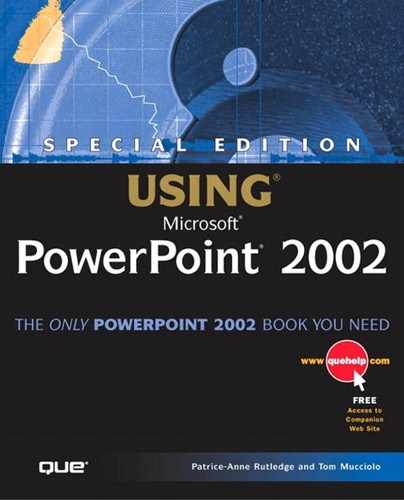Understanding Animation
PowerPoint includes a multitude of animation options. You can use animation to change from one slide to another in your presentation or to introduce objects and text on a slide. You can also customize these basic animations in a variety of ways. Additional animation options include the capability to have action buttons or other objects perform a specific action in your presentation, such as opening a Web page on the Internet.
Like most of PowerPoint's capabilities, animation can be either very simple or detailed and complex. It all depends on how creative and sophisticated you want to make your presentation. Animation can definitely enliven any presentation, but as with any special effect, be careful not to overdo. Too much animation can actually detract from your presentation; it also increases its file size.
→ To learn more about animation and visual design, see Chapter 23, “The Media—Designing Visual Support.”
PowerPoint includes a variety of animation options, which can be overwhelming if you're not sure about what each one does. Depending on what you want to animate (slide, text, drawing object, chart, media clip, and so forth) and what type of animation you want to use (a direction or an action), you have several ways to create the desired animation effect in PowerPoint. Your basic choices include the following:
Slide transitions Enable you to determine how to change from one slide to the next in your presentation.
Animation schemes Enable you to animate PowerPoint objects, such as text or drawing objects, using directional effects similar to slide transitions. For example, you can use an animation scheme to dissolve or wipe title text into your presentation.
Custom animation Enables you to set more sophisticated animation options, such as the order and timing of multiple animation objects in one slide. You can also use custom animation on charts and media clips such as sound and movie files.
Action settings Enable you to attach a mouse action to a PowerPoint object. For example, you can open a Web page, go to another slide, or start an external program by clicking the mouse or even just passing the mouse pointer over the selected object. An action setting differs from the previous types of animation in that it performs an action rather than defines how to introduce directionally an object or slide.
Action buttons Enable you to attach an action to a specific button. An action button is a predefined object that includes an action setting. You can attach an action setting to an object you create, or you can use one of the existing action buttons instead.
